Global Personal Care Ingredients Market Forecast
- The personal care ingredients market size will reach US$16.2 Bn in 2030, up from US$12.1 Bn recorded in 2022.
- Market revenue anticipated to expand at a CAGR of 4.30% between 2023 - 2030.
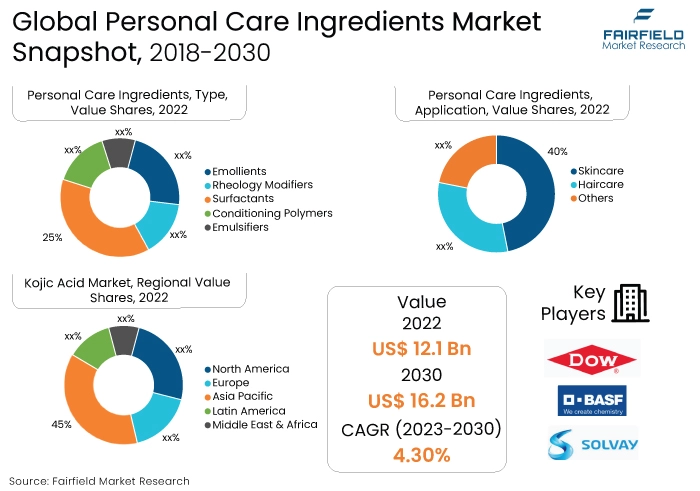
Quick Report Digest
- The key trend anticipated to fuel the Personal Care Ingredients market growth is the increasing awareness among consumers about the adverse effects of chemical-based personal care products, which has driven the demand for natural and organic ingredients.
- Another major market trend expected to fuel ongoing research and development activities in the field of skincare and haircare formulations has led to the introduction of advanced and specialised personal care ingredients.
- The growing disposable income in emerging economies, particularly in Asia Pacific, has resulted in an increased spending capacity on personal grooming products.
- In 2022, Emollients, known for their skin-softening and moisturizing properties, dominate the personal care ingredients market. They are extensively used in skincare and haircare products, providing a smooth texture and hydrating effect.
- Conditioning polymers are the fastest-growing category in the personal care ingredients market. These polymers are widely utilised in haircare products for their ability to enhance hair texture, reduce frizz, and improve overall manageability.
- In 2022, Skincare products, including creams, lotions, serums, and cleansers, constitute the dominant category in the personal care ingredients market.
- Asia Pacific remains the dominant region in the global personal care ingredients market. The region is characterised by a thriving cosmetics industry, driven by the rising consumer awareness about personal grooming, skincare, and haircare.
- North America is the fastest-growing region in the personal care ingredients market. The region's growth is propelled by continuous product innovations, a strong focus on natural and organic ingredients, and the increasing demand for premium personal care products.
A Look Back and a Look Forward - Comparative Analysis
The personal care ingredients market is experiencing robust growth, driven by increasing consumer awareness regarding personal grooming and hygiene. Demand for natural and organic ingredients has surged, with consumers seeking safer and eco-friendly alternatives.
Emollients, surfactants, and conditioning polymers are in high demand due to their diverse applications in skincare and haircare products. Furthermore, technological advancements and innovative formulations are shaping the market, creating a competitive landscape.
The market witnessed staggered growth during the historical period 2018 – 2022. The personal care ingredients market witnessed significant growth. The industry experienced a paradigm shift towards sustainability, leading to the introduction of bio-based ingredients and eco-friendly packaging solutions.
Skincare products dominated the market, with a surge in demand for anti-aging and moisturizing formulations. Haircare products also saw remarkable growth, driven by innovations in hair repair and natural ingredient-based shampoos and conditioners.
The personal care ingredients market is poised for continuous expansion. Anticipated trends include the rise of customised products catering to specific skin and hair types, the incorporation of advanced biotechnological ingredients, and an increased focus on natural preservatives.
The industry is expected to witness substantial investments in research and development, resulting in novel ingredients with enhanced benefits. Moreover, digitalisation will play a crucial role, allowing companies to understand consumer preferences better and offer tailored solutions.
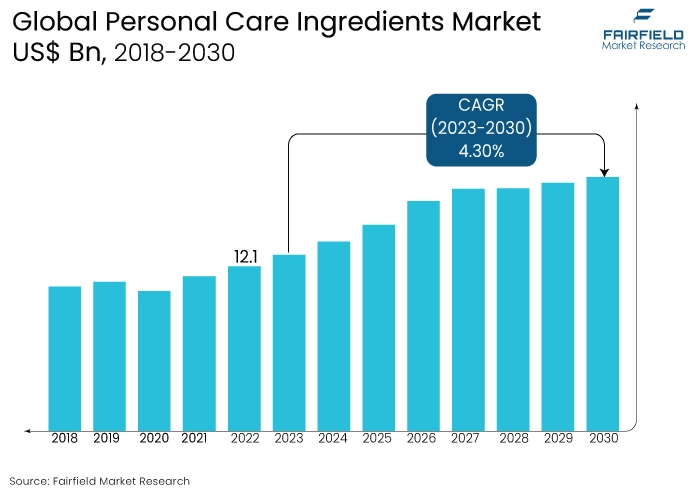
Key Growth Determinants
- Consumer Demand for Natural and Organic Products
The personal care ingredients market is the increasing consumer preference for natural and organic products. With growing awareness about the harmful effects of synthetic chemicals, consumers are actively seeking products formulated with natural ingredients.
This demand surge has pushed cosmetic companies to innovate and incorporate botanical extracts, essential oils, and organic compounds into their formulations.
Manufacturers are continuously investing in research to develop effective natural ingredients that provide various skincare and haircare benefits. This trend not only satisfies consumer demand for safer products but also fuels the market's growth as companies expand their portfolios with eco-friendly alternatives.
- Technological Advancements, and Product Innovation
Technological advancements have revolutionised the personal care ingredients industry. Continuous research and development efforts have led to the discovery of novel ingredients with unique properties. For instance, the development of microencapsulation technology has enabled the controlled release of active ingredients, enhancing the efficacy of skincare products.
Additionally, innovations in biotechnology have paved the way for bio-based ingredients, reducing the industry's environmental footprint. These advancements drive market growth by allowing manufacturers to create cutting-edge formulations that cater to specific skincare and haircare needs.
- Changing Consumer Lifestyles and Preferences
Shifts in consumer lifestyles, influenced by factors such as urbanisation, increased disposable income, and social media exposure, significantly impact the personal care ingredients market. As consumers become more health-conscious and appearance-focused, the demand for premium skincare and haircare products rises.
Additionally, changing cultural perceptions of beauty and grooming have led to a diversified range of products catering to various skin types, textures, and tones.
This diversity drives the need for a wide array of specialised ingredients, stimulating innovation in the industry. Furthermore, the trend of self-care and wellness has encouraged the development of personal care products infused with ingredients that promote relaxation and overall well-being.
Major Growth Barriers
- Regulatory Challenges, and Compliance Issues
The personal care ingredients market is a stringent regulatory environment. Regulatory bodies across the globe continuously update and enforce guidelines regarding the safety and efficacy of cosmetic ingredients.
Compliance with these regulations often necessitates extensive testing and documentation, increasing the time and cost involved in bringing new products to market.
Moreover, varying regulations in different regions create complexities for multinational companies, leading to challenges in standardising formulations. Navigating these regulatory hurdles requires substantial investments, hindering the market's agility and innovation.
- Supply Chain Disruptions, and Raw Material Costs
The personal care ingredients market faces challenges related to supply chain disruptions and fluctuating raw material costs. Natural ingredients are especially susceptible to supply chain disturbances due to factors like climate change, natural disasters, or geopolitical tensions. These disruptions can lead to shortages, affecting production schedules and product availability.
Additionally, the costs of raw materials, especially natural and exotic ingredients, are often volatile. Price fluctuations impact manufacturing budgets and profitability, compelling companies to either absorb the increased costs or pass them on to consumers, potentially affecting market competitiveness.
Key Trends and Opportunities to Look at
- Sustainability, and Natural Ingredients
Consumers' growing eco-consciousness fuels the demand for sustainable and natural personal care ingredients. Brands are increasingly sourcing organic and plant-based materials, promoting transparency, and adopting eco-friendly packaging. This trend is global, with companies in Europe and North America leading the way, emphasizing environmentally responsible practices to meet consumer expectations for greener products.
- Advanced Biotechnological Innovations
Biotechnological advancements, including fermentation and synthetic biology, are revolutionising ingredient production. These innovations enable the creation of novel compounds mimicking natural ingredients' benefits.
Companies are investing in research and partnerships to develop bioengineered ingredients with enhanced properties. Asia Pacific, particularly in countries like Japan, and South Korea, showcases the rapid adoption of biotechnological breakthroughs in skincare formulations.
- Customisation, and Personalisation
Personalised beauty solutions are gaining traction, with brands tailoring products to individual consumers. Technology-driven tools, such as AI and machine learning algorithms, analyse skin types and preferences, allowing brands to create bespoke formulations.
This trend is prominent in North America and Asia Pacific, where tech-savvy consumers seek tailored products that cater to specific skin concerns, fostering customer loyalty and brand differentiation.
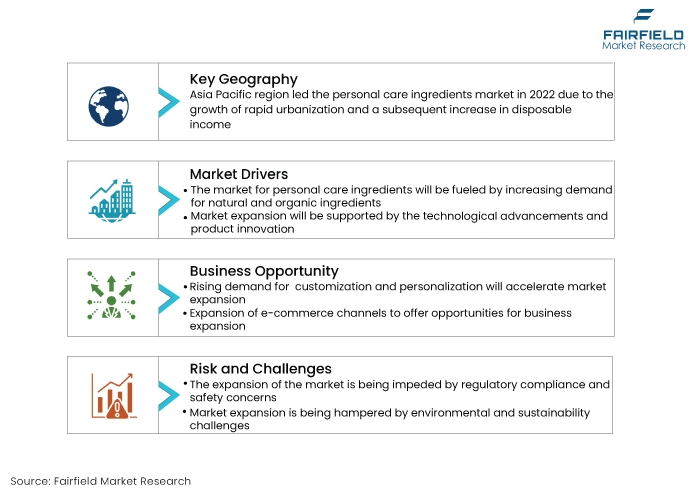
How Does the Regulatory Scenario Shape this Industry?
The personal care ingredients market is intricately shaped by a complex regulatory landscape that varies across regions. Key regulatory entities include the U.S. Food and Drug Administration (FDA) in the United States, the European Commission in the European Union, and the China Food and Drug Administration (CFDA) in China. These entities enforce regulations and guidelines that govern the safety, labelling, and composition of personal care products.
In recent years, there has been a global shift towards stricter regulations focusing on consumer safety and environmental impact. For instance, the European Union’s REACH (Registration, Evaluation, Authorisation, and Restriction of Chemicals) regulation mandates the registration and evaluation of chemicals, impacting ingredient suppliers.
Additionally, there's a growing emphasis on banning or restricting certain chemicals, like parabens and phthalates, due to their potential health risks. Region-specific changes are evident, such as China's new Cosmetic Supervision and Administration Regulation (CSAR), which imposes rigorous requirements on cosmetics imported into China.
Fairfield’s Ranking Board
Top Segments
- Surfactants Continue to Dominate over Emollients
Surfactants have established themselves as the dominant category in the personal care ingredients market in 2022, commanding a significant market share of approximately 25%. Surfactants play a pivotal role in various personal care products, such as shampoos, shower gels, and facial cleansers, where consumers highly value their foaming and cleansing properties.
An increasing emphasis on cleanliness and hygiene, along with the growing demand for specialised skincare and haircare solutions, has contributed to the dominance of surfactants in the industry.
Furthermore, Emollients emerged as the fastest-growing category within the personal care ingredients market, witnessing robust expansion and capturing a market share of approximately 15%. These versatile ingredients are in high demand for their ability to provide hydration, softness, and a smooth texture to the skin and hair.
Emollients find extensive application in moisturizers, lotions, lip balms, and hair conditioners, catering to the evolving preferences of consumers for products that enhance skin and hair health.
- Skincare Will Surge Ahead Throughout the Forecast Period
In 2022, Skincare products hold the dominant position in the personal care ingredients market, capturing a substantial market share of approximately 40%. The skincare segment's dominance can be attributed to the increasing awareness among consumers regarding the importance of skincare routines, driven by factors such as rising pollution levels, exposure to harmful UV rays, and the desire for youthful and healthy-looking skin.
Haircare products emerge as the fastest-growing category within the personal care ingredients market, experiencing rapid expansion and capturing a market share of approximately 20%. The growing focus on hair health and appearance, coupled with the rise in hair-related concerns such as hair fall, dandruff, and hair damage, has significantly boosted the demand for specialised haircare products.
Consumers are increasingly inclined towards natural and organic ingredients like plant oils, herbal extracts, and vitamins in their haircare products, contributing to the surge in this segment.
Regional Frontrunners
Asia Pacific Remains the Prime Revenue Contributor
Asia Pacific stands as the largest revenue-contributing region in the global personal care ingredients market, commanding a significant market share of around 45%. This regional dominance can be attributed to several factors. Firstly, the region's booming population, especially in countries like China, and India, has led to a substantial consumer base with diverse personal care needs.
Additionally, rising disposable incomes and urbanisation have elevated the demand for premium personal care products enriched with high-quality ingredients. Moreover, Asia Pacific is a hub for innovation and research in the cosmetics and personal care industry.
Local and multinational companies in countries like South Korea, and Japan are pioneers in introducing novel ingredients and formulations, catering to evolving consumer preferences. Furthermore, the region's cultural emphasis on skincare and grooming rituals has created a robust market for a wide array of personal care products.
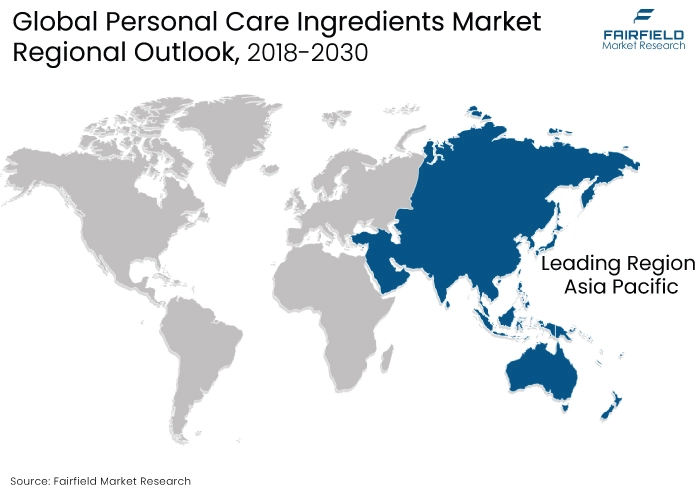
North America Likely to Witness Significant Growth in Demand
North America is poised to witness substantial growth in sales during the forecast period, with a projected market share of approximately 30%. Several factors contribute to this region's promising outlook. Firstly, the increasing consumer focus on personal grooming, health, and wellness has driven the demand for high-quality personal care products.
The region's affluent population is willing to invest in premium products, fostering a lucrative market for a diverse range of personal care ingredients. Additionally, the presence of well-established cosmetic and personal care companies in North America fosters a culture of innovation.
Companies here are investing significantly in research and development, leading to the introduction of cutting-edge ingredients and formulations. Furthermore, the region's consumers are increasingly conscious about the ingredients used in their personal care products, driving the demand for natural, organic, and sustainable ingredients.
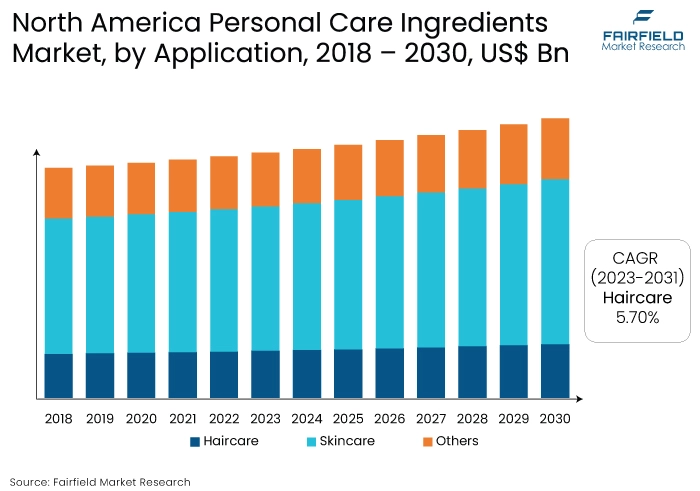
Fairfield’s Competitive Landscape Analysis
In the intensely competitive personal care ingredients market, innovation and diversification will be pivotal. Companies that can offer not only high-quality ingredients but also unique formulations and customisation options are likely to dominate.
Collaboration between ingredient suppliers and cosmetic manufacturers will drive synergy, creating products that stand out in the market. Pricing strategies will be critical, with affordability being a key factor for consumers. Striking a balance between high-quality, ethically sourced ingredients and reasonable pricing will be a challenge.
Who are the Leaders in the Global Personal Care Ingredients Space?
- BASF SE
- The Dow Chemical Company
- Solvay
- Evonik Industries AG
- Clariant AG
- Nouryon
- Croda International Plc
- Lubrizol Corporation
- Adeka Corporation
- Air Liquide
- Corbion N.V.
- Eastman Chemical Company
- Elementis Plc
- Dupont
- Innospec Inc.
Significant Company Developments
New Product Launch
- In August 2020, SE recently launched a brand new production line at its facility in Kaohsiung, Taiwan. The goal of this expansion is to significantly increase the production of Uvinul A Plus, a crucial ingredient utilised for safeguarding against UVA (ultraviolet longest wavelength) rays. This ingredient is widely incorporated in different formulations for sun and skin care. The introduction of this production line is a direct response to the escalating demand from consumers in the Asia Pacific region.
- February 2020: Dow showcased sustainable beauty formulation and ACULYN rheology modifiers. This product reduces carbon footprint and is very easy to use.
Distribution Agreement
- In July 2020, SE and Isobionics, a company based in the Netherlands, recently introduced a collaborative offering known as Isobionics Santalol. This innovative product is derived from a sustainable source, making it an excellent substitute for sandalwood oil.
- In June 2020, BTC Europe has been selected as a distribution partner by SE for its care creation portfolio. This collaboration brings together the entire portfolio in a single location, enhancing productivity and streamlining the supply chain for customers in the personal care industry.
An Expert’s Eye
Demand and Future Growth
The increasing awareness among consumers about the ingredients used in personal care products, fuelled by concerns about health and environmental sustainability, will continue to shape market demands.
In the long term, the demand for natural, organic, and cruelty-free ingredients is anticipated to surge as consumers seek products aligned with their eco-conscious values. This trend is likely to catalyse innovation in the industry, with companies investing in research and development to create sustainable alternatives.
Supply Side of the Market
The supply side of the personal care ingredients market faces challenges related to sustainability and sourcing. Ethical sourcing of ingredients, fair trade practices, and ecological responsibility are becoming critical considerations. Ingredient suppliers are under pressure to ensure a transparent and ethical supply chain, from sourcing raw materials to their delivery to manufacturers.
Climate change and environmental concerns pose a long-term challenge, impacting the cultivation and availability of certain natural ingredients. Balancing the demand for natural ingredients with sustainable practices will be crucial to maintaining a stable supply chain. Collaborations with local farmers and investing in sustainable agricultural practices can mitigate these challenges.
Global Personal Care Ingredients Market is Segmented as Below:
By Type:
- Emollients
- Surfactants
- Rheology Modifiers
- Emulsifiers
- Conditioning Polymers
By Application:
- Skincare
- Haircare
- Others
By Geographic Coverage:
- North America
- U.S.
- Canada
- Europe
- Germany
- U.K.
- France
- Italy
- Turkey
- Russia
- Rest of Europe
- Asia Pacific
- China
- Japan
- South Korea
- India
- Southeast Asia
- Rest of Asia Pacific
- Latin America
- Brazil
- Mexico
- Argentina
- Rest of Latin America
- Middle East & Africa
- GCC
- South Africa
- Egypt
- Nigeria
- Rest of the Middle East & Africa
1. Executive Summary
1.1. Global Personal Care Ingredients Market Snapshot
1.2. Future Projections
1.3. Key Market Trends
1.4. Regional Snapshot, by Value/Volume, 2022
1.5. Analyst Recommendations
2. Market Overview
2.1. Market Definitions and Segmentations
2.2. Market Dynamics
2.2.1. Drivers
2.2.2. Restraints
2.2.3. Market Opportunities
2.3. Value Chain Analysis
2.4. Porter’s Five Forces Analysis
2.5. Covid-19 Impact Analysis
2.5.1. Supply
2.5.2. Demand
2.6. Impact of Ukraine-Russia Conflict
2.7. Economic Overview
2.7.1. World Economic Projections
2.8. PESTLE Analysis
3. Global Personal Care Ingredients Market Outlook, 2018 - 2030
3.1. Global Personal Care Ingredients Market Outlook, by Type, Value (US$ Bn), 2018 - 2030
3.1.1. Key Highlights
3.1.1.1. Emollients
3.1.1.2. Surfactants
3.1.1.3. Rheology Modifiers
3.1.1.4. Emulsifiers
3.1.1.5. Conditioning Polymers
3.2. Global Personal Care Ingredients Market Outlook, by Application, Value (US$ Bn), 2018 - 2030
3.2.1. Key Highlights
3.2.1.1. Skincare
3.2.1.2. Haircare
3.2.1.3. Others
3.3. Global Personal Care Ingredients Market Outlook, by Region, Value (US$ Bn), 2018 - 2030
3.3.1. Key Highlights
3.3.1.1. North America
3.3.1.2. Europe
3.3.1.3. Asia Pacific
3.3.1.4. Latin America
3.3.1.5. Middle East & Africa
4. North America Personal Care Ingredients Market Outlook, 2018 - 2030
4.1. North America Personal Care Ingredients Market Outlook, by Type, Value (US$ Bn), 2018 - 2030
4.1.1. Key Highlights
4.1.1.1. Emollients
4.1.1.2. Surfactants
4.1.1.3. Rheology Modifiers
4.1.1.4. Emulsifiers
4.1.1.5. Conditioning Polymers
4.2. North America Personal Care Ingredients Market Outlook, by Application, Value (US$ Bn), 2018 - 2030
4.2.1. Key Highlights
4.2.1.1. Skincare
4.2.1.2. Haircare
4.2.1.3. Others
4.2.2. BPS Analysis/Market Attractiveness Analysis
4.3. North America Personal Care Ingredients Market Outlook, by Country, Value (US$ Bn), 2018 - 2030
4.3.1. Key Highlights
4.3.1.1. U.S. Personal Care Ingredients Market by Type, Value (US$ Bn), 2018 - 2030
4.3.1.2. U.S. Personal Care Ingredients Market Application, Value (US$ Bn), 2018 - 2030
4.3.1.3. Canada Personal Care Ingredients Market by Type, Value (US$ Bn), 2018 - 2030
4.3.1.4. Canada Personal Care Ingredients Market Application, Value (US$ Bn), 2018 - 2030
4.3.2. BPS Analysis/Market Attractiveness Analysis
5. Europe Personal Care Ingredients Market Outlook, 2018 - 2030
5.1. Europe Personal Care Ingredients Market Outlook, by Type, Value (US$ Bn), 2018 - 2030
5.1.1. Key Highlights
5.1.1.1. Emollients
5.1.1.2. Surfactants
5.1.1.3. Rheology Modifiers
5.1.1.4. Emulsifiers
5.1.1.5. Conditioning Polymers
5.2. Europe Personal Care Ingredients Market Outlook, by Application, Value (US$ Bn), 2018 - 2030
5.2.1. Key Highlights
5.2.1.1. Skincare
5.2.1.2. Haircare
5.2.1.3. Others
5.2.2. BPS Analysis/Market Attractiveness Analysis
5.3. Europe Personal Care Ingredients Market Outlook, by Country, Value (US$ Bn), 2018 - 2030
5.3.1. Key Highlights
5.3.1.1. Germany Personal Care Ingredients Market by Type, Value (US$ Bn), 2018 - 2030
5.3.1.2. Germany Personal Care Ingredients Market Application, Value (US$ Bn), 2018 - 2030
5.3.1.3. U.K. Personal Care Ingredients Market by Type, Value (US$ Bn), 2018 - 2030
5.3.1.4. U.K. Personal Care Ingredients Market Application, Value (US$ Bn), 2018 - 2030
5.3.1.5. France Personal Care Ingredients Market by Type, Value (US$ Bn), 2018 - 2030
5.3.1.6. France Personal Care Ingredients Market Application, Value (US$ Bn), 2018 - 2030
5.3.1.7. Italy Personal Care Ingredients Market by Type, Value (US$ Bn), 2018 - 2030
5.3.1.8. Italy Personal Care Ingredients Market Application, Value (US$ Bn), 2018 - 2030
5.3.1.9. Turkey Personal Care Ingredients Market by Type, Value (US$ Bn), 2018 - 2030
5.3.1.10. Turkey Personal Care Ingredients Market Application, Value (US$ Bn), 2018 - 2030
5.3.1.11. Russia Personal Care Ingredients Market by Type, Value (US$ Bn), 2018 - 2030
5.3.1.12. Russia Personal Care Ingredients Market Application, Value (US$ Bn), 2018 - 2030
5.3.1.13. Rest of Europe Personal Care Ingredients Market by Type, Value (US$ Bn), 2018 - 2030
5.3.1.14. Rest of Europe Personal Care Ingredients Market Application, Value (US$ Bn), 2018 - 2030
5.3.2. BPS Analysis/Market Attractiveness Analysis
6. Asia Pacific Personal Care Ingredients Market Outlook, 2018 - 2030
6.1. Asia Pacific Personal Care Ingredients Market Outlook, by Type, Value (US$ Bn), 2018 - 2030
6.1.1. Key Highlights
6.1.1.1. Emollients
6.1.1.2. Surfactants
6.1.1.3. Rheology Modifiers
6.1.1.4. Emulsifiers
6.1.1.5. Conditioning Polymers
6.2. Asia Pacific Personal Care Ingredients Market Outlook, by Application, Value (US$ Bn), 2018 - 2030
6.2.1. Key Highlights
6.2.1.1. Skincare
6.2.1.2. Haircare
6.2.1.3. Others
6.2.2. BPS Analysis/Market Attractiveness Analysis
6.3. Asia Pacific Personal Care Ingredients Market Outlook, by Country, Value (US$ Bn), 2018 - 2030
6.3.1. Key Highlights
6.3.1.1. China Personal Care Ingredients Market by Type, Value (US$ Bn), 2018 - 2030
6.3.1.2. China Personal Care Ingredients Market Application, Value (US$ Bn), 2018 - 2030
6.3.1.3. Japan Personal Care Ingredients Market by Type, Value (US$ Bn), 2018 - 2030
6.3.1.4. Japan Personal Care Ingredients Market Application, Value (US$ Bn), 2018 - 2030
6.3.1.5. South Korea Personal Care Ingredients Market by Type, Value (US$ Bn), 2018 - 2030
6.3.1.6. South Korea Personal Care Ingredients Market Application, Value (US$ Bn), 2018 - 2030
6.3.1.7. India Personal Care Ingredients Market by Type, Value (US$ Bn), 2018 - 2030
6.3.1.8. India Personal Care Ingredients Market Application, Value (US$ Bn), 2018 - 2030
6.3.1.9. Southeast Asia Personal Care Ingredients Market by Type, Value (US$ Bn), 2018 - 2030
6.3.1.10. Southeast Asia Personal Care Ingredients Market Application, Value (US$ Bn), 2018 - 2030
6.3.1.11. Rest of Asia Pacific Personal Care Ingredients Market by Type, Value (US$ Bn), 2018 - 2030
6.3.1.12. Rest of Asia Pacific Personal Care Ingredients Market Application, Value (US$ Bn), 2018 - 2030
6.3.2. BPS Analysis/Market Attractiveness Analysis
7. Latin America Personal Care Ingredients Market Outlook, 2018 - 2030
7.1. Latin America Personal Care Ingredients Market Outlook, by Type, Value (US$ Bn), 2018 - 2030
7.1.1. Key Highlights
7.1.1.1. Emollients
7.1.1.2. Surfactants
7.1.1.3. Rheology Modifiers
7.1.1.4. Emulsifiers
7.1.1.5. Conditioning Polymers
7.2. Latin America Personal Care Ingredients Market Outlook, by Application, Value (US$ Bn), 2018 - 2030
7.2.1. Key Highlights
7.2.1.1. Skincare
7.2.1.2. Haircare
7.2.1.3. Others
7.2.2. BPS Analysis/Market Attractiveness Analysis
7.3. Latin America Personal Care Ingredients Market Outlook, by Country, Value (US$ Bn), 2018 - 2030
7.3.1. Key Highlights
7.3.1.1. Brazil Personal Care Ingredients Market by Type, Value (US$ Bn), 2018 - 2030
7.3.1.2. Brazil Personal Care Ingredients Market Application, Value (US$ Bn), 2018 - 2030
7.3.1.3. Mexico Personal Care Ingredients Market by Type, Value (US$ Bn), 2018 - 2030
7.3.1.4. Mexico Personal Care Ingredients Market Application, Value (US$ Bn), 2018 - 2030
7.3.1.5. Argentina Personal Care Ingredients Market by Type, Value (US$ Bn), 2018 - 2030
7.3.1.6. Argentina Personal Care Ingredients Market Application, Value (US$ Bn), 2018 - 2030
7.3.1.7. Rest of Latin America Personal Care Ingredients Market by Type, Value (US$ Bn), 2018 - 2030
7.3.1.8. Rest of Latin America Personal Care Ingredients Market Application, Value (US$ Bn), 2018 - 2030
7.3.2. BPS Analysis/Market Attractiveness Analysis
8. Middle East & Africa Personal Care Ingredients Market Outlook, 2018 - 2030
8.1. Middle East & Africa Personal Care Ingredients Market Outlook, by Type, Value (US$ Bn), 2018 - 2030
8.1.1. Key Highlights
8.1.1.1. Emollients
8.1.1.2. Surfactants
8.1.1.3. Rheology Modifiers
8.1.1.4. Emulsifiers
8.1.1.5. Conditioning Polymers
8.2. Middle East & Africa Personal Care Ingredients Market Outlook, by Application, Value (US$ Bn), 2018 - 2030
8.2.1. Key Highlights
8.2.1.1. Skincare
8.2.1.2. Haircare
8.2.1.3. Others
8.2.2. BPS Analysis/Market Attractiveness Analysis
8.3. Middle East & Africa Personal Care Ingredients Market Outlook, by Country, Value (US$ Bn), 2018 - 2030
8.3.1. Key Highlights
8.3.1.1. GCC Personal Care Ingredients Market by Type, Value (US$ Bn), 2018 - 2030
8.3.1.2. GCC Personal Care Ingredients Market Application, Value (US$ Bn), 2018 - 2030
8.3.1.3. South Africa Personal Care Ingredients Market by Type, Value (US$ Bn), 2018 - 2030
8.3.1.4. South Africa Personal Care Ingredients Market Application, Value (US$ Bn), 2018 - 2030
8.3.1.5. Egypt Personal Care Ingredients Market by Type, Value (US$ Bn), 2018 - 2030
8.3.1.6. Egypt Personal Care Ingredients Market Application, Value (US$ Bn), 2018 - 2030
8.3.1.7. Nigeria Personal Care Ingredients Market by Type, Value (US$ Bn), 2018 - 2030
8.3.1.8. Nigeria Personal Care Ingredients Market Application, Value (US$ Bn), 2018 - 2030
8.3.1.9. Rest of Middle East & Africa Personal Care Ingredients Market by Type, Value (US$ Bn), 2018 - 2030
8.3.1.10. Rest of Middle East & Africa Personal Care Ingredients Market Application, Value (US$ Bn), 2018 - 2030
8.3.2. BPS Analysis/Market Attractiveness Analysis
9. Competitive Landscape
9.1. Manufacturer vs Application Heatmap
9.2. Company Market Share Analysis, 2022
9.3. Competitive Dashboard
9.4. Company Profiles
9.4.1. BASF SE
9.4.1.1. Company Overview
9.4.1.2. Product Portfolio
9.4.1.3. Financial Overview
9.4.1.4. Business Strategies and Development
9.4.2. The Dow Chemical Company
9.4.2.1. Company Overview
9.4.2.2. Product Portfolio
9.4.2.3. Financial Overview
9.4.2.4. Business Strategies and Development
9.4.3. Solvay
9.4.3.1. Company Overview
9.4.3.2. Product Portfolio
9.4.3.3. Financial Overview
9.4.3.4. Business Strategies and Development
9.4.4. Evonik Industries AG
9.4.4.1. Company Overview
9.4.4.2. Product Portfolio
9.4.4.3. Financial Overview
9.4.4.4. Business Strategies and Development
9.4.5. Clariant AG
9.4.5.1. Company Overview
9.4.5.2. Product Portfolio
9.4.5.3. Financial Overview
9.4.5.4. Business Strategies and Development
9.4.6. Nouryon
9.4.6.1. Company Overview
9.4.6.2. Product Portfolio
9.4.6.3. Financial Overview
9.4.6.4. Business Strategies and Development
9.4.7. Croda International Plc
9.4.7.1. Company Overview
9.4.7.2. Product Portfolio
9.4.7.3. Financial Overview
9.4.7.4. Business Strategies and Development
9.4.8. Lubrizol Corporation
9.4.8.1. Company Overview
9.4.8.2. Product Portfolio
9.4.8.3. Business Strategies and Development
9.4.9. Adeka Corporation
9.4.9.1. Company Overview
9.4.9.2. Product Portfolio
9.4.9.3. Financial Overview
9.4.9.4. Business Strategies and Development
9.4.10. Air Liquide
9.4.10.1. Company Overview
9.4.10.2. Product Portfolio
9.4.10.3. Financial Overview
9.4.10.4. Business Strategies and Development
9.4.11. Corbion N.V.
9.4.11.1. Company Overview
9.4.11.2. Product Portfolio
9.4.11.3. Financial Overview
9.4.11.4. Business Strategies and Development
9.4.12. Eastman Chemical Company
9.4.12.1. Company Overview
9.4.12.2. Product Portfolio
9.4.12.3. Financial Overview
9.4.12.4. Business Strategies and Development
9.4.13. Elementis Plc
9.4.13.1. Company Overview
9.4.13.2. Product Portfolio
9.4.13.3. Financial Overview
9.4.13.4. Business Strategies and Development
9.4.14. Dupont
9.4.14.1. Company Overview
9.4.14.2. Product Portfolio
9.4.14.3. Financial Overview
9.4.14.4. Business Strategies and Development
9.4.15. Innospec Inc.
9.4.15.1. Company Overview
9.4.15.2. Product Portfolio
9.4.15.3. Financial Overview
9.4.15.4. Business Strategies and Development
10. Appendix
10.1. Research Methodology
10.2. Report Assumptions
10.3. Acronyms and Abbreviations
|
BASE YEAR |
HISTORICAL DATA |
FORECAST PERIOD |
UNITS |
|||
|
2022 |
|
2018 - 2022 |
2023 - 2030 |
Value: US$ Billion |
||
|
REPORT FEATURES |
DETAILS |
|
Type Coverage |
|
|
Application Coverage |
|
|
Geographical Coverage |
|
|
Leading Companies |
|
|
Report Highlights |
Key Market Indicators, Macro-micro economic impact analysis, Technological Roadmap, Key Trends, Driver, Restraints, and Future Opportunities & Revenue Pockets, Porter’s 5 Forces Analysis, Historical Trend (2019-2021), Market Estimates and Forecast, Market Dynamics, Industry Trends, Competition Landscape, Category, Region, Country-wise Trends & Analysis, COVID-19 Impact Analysis (Demand and Supply Chain) |
